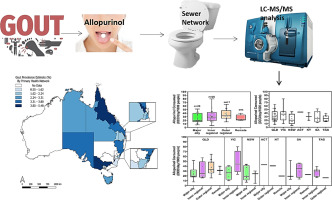当前位置:
X-MOL 学术
›
Sci. Total Environ.
›
论文详情
Our official English website, www.x-mol.net, welcomes your
feedback! (Note: you will need to create a separate account there.)
Wastewater-based estimation of the prevalence of gout in Australia.
Science of the Total Environment ( IF 8.2 ) Pub Date : 2020-01-25 , DOI: 10.1016/j.scitotenv.2020.136925 Fahad Ahmed 1 , Benjamin Tscharke 1 , Jake O'Brien 1 , Jack Thompson 1 , Saer Samanipour 2 , Phil Choi 1 , Jiaying Li 3 , Jochen F Mueller 1 , Kevin Thomas 1
Science of the Total Environment ( IF 8.2 ) Pub Date : 2020-01-25 , DOI: 10.1016/j.scitotenv.2020.136925 Fahad Ahmed 1 , Benjamin Tscharke 1 , Jake O'Brien 1 , Jack Thompson 1 , Saer Samanipour 2 , Phil Choi 1 , Jiaying Li 3 , Jochen F Mueller 1 , Kevin Thomas 1
Affiliation

|
Allopurinol, a first-line gout treatment drug in Australia, was assessed as a wastewater-based epidemiology biomarker of gout via quantification of the urinary metabolite, oxypurinol in wastewater. The in-sewer stability of oxypurinol was examined using laboratory-scale sewer reactors. Wastewater from 75 wastewater treatment plants across Australia, covering approximately 52% (12.2 million) of the country's population, was collected on the 2016 census day. Oxypurinol was quantified in the wastewater samples and population-weighted mass loads calculated. Pearson and Spearman rank-order correlations were applied to investigate any link between allopurinol, other selected wastewater biomarkers, and socio-economic indicators. Oxypurinol was shown to be stable in sewer conditions and suitable as a WBE biomarker. Oxypurinol was detected in all wastewater samples. The estimated consumption of allopurinol ranged from 1.9 to 32 g/day/1000 people equating to 4.8 to 80 DDD/day/1000 people. The prevalence of gout across all tested sewer catchments was between 0.5% to 8%, with a median of 2.9% nationally. No significant positive correlation was observed between allopurinol consumption and alcohol consumption, mean age of catchment population, remoteness or higher socioeconomic status. There was a significant positive correlation with selective analgesic drug use. Wastewater analysis can be used to study gout prevalence and can provide additional insights on population level risk factors when triangulated with other biomarkers.
中文翻译:

基于废水的澳大利亚痛风患病率估算。
别嘌醇是痛风的一线治疗药物,通过量化废水中的尿代谢产物氧嘌呤醇,被评估为基于痛风的废水流行病学生物标志物。使用实验室规模的下水道反应器检查了氧嘌呤醇在下水道的稳定性。2016年普查日收集了澳大利亚75个污水处理厂的废水,约占该国人口的52%(1,220万)。在废水样品中对羟嘌呤醇进行定量,并计算人口加权质量负荷。皮尔逊和斯皮尔曼等级顺序相关性用于调查别嘌醇,其他选定的废水生物标志物和社会经济指标之间的任何联系。氧杂嘌呤在下水道条件下显示稳定,适合作为WBE生物标志物。在所有废水样品中均检测到了氧杂嘌呤。别嘌醇的估计消费量为1.9至32 g /天/ 1000人,相当于4.8至80 DDD /天/ 1000人。在所有测试的下水道集水区中,痛风的患病率在0.5%至8%之间,全国中位数为2.9%。在摄入别嘌醇和饮酒,流域人口的平均年龄,偏远或较高的社会经济地位之间未观察到显着正相关。与选择性镇痛药的使用有显着的正相关。废水分析可用于研究痛风的发生率,并在与其他生物标记物进行三角剖分时可提供有关人口水平危险因素的其他见解。在所有测试的下水道集水区中,痛风的患病率在0.5%至8%之间,全国中位数为2.9%。别嘌呤醇摄入量与酒精摄入量,流域人口平均年龄,偏远地区或较高的社会经济地位之间未发现显着正相关。与选择性镇痛药的使用有显着的正相关。废水分析可用于研究痛风的发生率,并在与其他生物标记物进行三角剖分时可提供有关人口水平危险因素的其他见解。在所有测试的下水道集水区中,痛风的患病率在0.5%至8%之间,全国中位数为2.9%。别嘌呤醇摄入量与酒精摄入量,流域人口平均年龄,偏远地区或较高的社会经济地位之间未发现显着正相关。与选择性镇痛药的使用有显着正相关。废水分析可用于研究痛风的发生率,并在与其他生物标记物进行三角剖分时可提供有关人口水平危险因素的其他见解。与选择性镇痛药的使用有显着的正相关。废水分析可用于研究痛风的发生率,并在与其他生物标记物进行三角剖分时可提供有关人口水平危险因素的其他见解。与选择性镇痛药的使用有显着的正相关。废水分析可用于研究痛风的发生率,并在与其他生物标记物进行三角剖分时可提供有关人口水平危险因素的其他见解。
更新日期:2020-01-26
中文翻译:

基于废水的澳大利亚痛风患病率估算。
别嘌醇是痛风的一线治疗药物,通过量化废水中的尿代谢产物氧嘌呤醇,被评估为基于痛风的废水流行病学生物标志物。使用实验室规模的下水道反应器检查了氧嘌呤醇在下水道的稳定性。2016年普查日收集了澳大利亚75个污水处理厂的废水,约占该国人口的52%(1,220万)。在废水样品中对羟嘌呤醇进行定量,并计算人口加权质量负荷。皮尔逊和斯皮尔曼等级顺序相关性用于调查别嘌醇,其他选定的废水生物标志物和社会经济指标之间的任何联系。氧杂嘌呤在下水道条件下显示稳定,适合作为WBE生物标志物。在所有废水样品中均检测到了氧杂嘌呤。别嘌醇的估计消费量为1.9至32 g /天/ 1000人,相当于4.8至80 DDD /天/ 1000人。在所有测试的下水道集水区中,痛风的患病率在0.5%至8%之间,全国中位数为2.9%。在摄入别嘌醇和饮酒,流域人口的平均年龄,偏远或较高的社会经济地位之间未观察到显着正相关。与选择性镇痛药的使用有显着的正相关。废水分析可用于研究痛风的发生率,并在与其他生物标记物进行三角剖分时可提供有关人口水平危险因素的其他见解。在所有测试的下水道集水区中,痛风的患病率在0.5%至8%之间,全国中位数为2.9%。别嘌呤醇摄入量与酒精摄入量,流域人口平均年龄,偏远地区或较高的社会经济地位之间未发现显着正相关。与选择性镇痛药的使用有显着的正相关。废水分析可用于研究痛风的发生率,并在与其他生物标记物进行三角剖分时可提供有关人口水平危险因素的其他见解。在所有测试的下水道集水区中,痛风的患病率在0.5%至8%之间,全国中位数为2.9%。别嘌呤醇摄入量与酒精摄入量,流域人口平均年龄,偏远地区或较高的社会经济地位之间未发现显着正相关。与选择性镇痛药的使用有显着正相关。废水分析可用于研究痛风的发生率,并在与其他生物标记物进行三角剖分时可提供有关人口水平危险因素的其他见解。与选择性镇痛药的使用有显着的正相关。废水分析可用于研究痛风的发生率,并在与其他生物标记物进行三角剖分时可提供有关人口水平危险因素的其他见解。与选择性镇痛药的使用有显着的正相关。废水分析可用于研究痛风的发生率,并在与其他生物标记物进行三角剖分时可提供有关人口水平危险因素的其他见解。











































 京公网安备 11010802027423号
京公网安备 11010802027423号